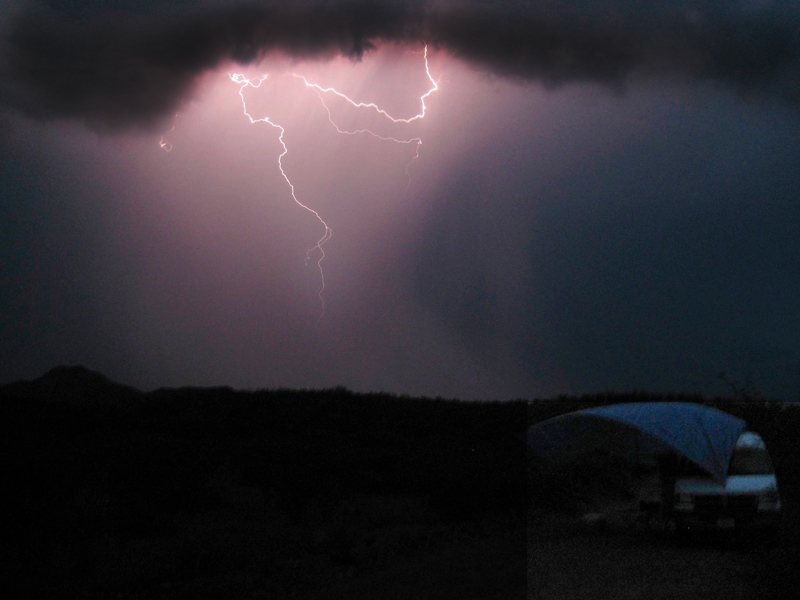Wow det har vært et par uker siden mitt siste innlegg, og jeg er litt flau å ha la det gå så lang tid. Hva har jeg vært opp til? Ikke en hel ikke. Ingen imponerende samle turer, ingen nye arter eller funn. Egentlig har jeg sittet på et mikroskop dissekere genitalia eller databasing parasittiske fluer. Jeg må lage et oppfølgingsinnlegg for å fordype meg litt mer…
Men inntil videre, her er et bildeskjema sist august. Jeg sto på en åpen strekning av Chihuahuan-ørkenen rett utenfor Douglas Arizona; en hel kilometer fra den meksikanske grensen. Jeg ankom den kvelden med samlerkollegaen min, mikrolepidopteri Peter Jump, og vi hadde nettopp satt opp leir da tordenrullen nærmet seg. Bortsett fra de utdødde slaggkjeglene som omgir oss og en og annen illegal innvandrer, vi var de eneste (og høyest) ting rundt i miles. Men lynet var for vanskelig å motstå, Jeg trenger et bilde! Men jeg hadde ikke en kabelutløser, heller ikke et stativ, eller til og med et godt kamera. Så, hva gjør vi… Jeg valgte det geniale alternativet å stå ute for 40 minutter med min Canon pek-og-skyt. jeg bommet 99% av hvert skudd jeg tok, mens lynet ble nærmere for hvert minutt som gikk. Endelig, Jeg snublet over dette greie bildet. Stormen endte opp med å bli kort, vi klemmer oss sammen i bilen (som du bare kan skimte på bildet) mens lynet nærmet seg og det duskregnet på oss i en time, så gikk det videre. Samlingen den kvelden var imponerende. Det var så mange møll i fella at alt hadde blitt slått i biter. Jeg klarte å redde en håndfull gode eksemplarer, men lærdom til neste gang.


Dazzling. I’ve found my best blacklighting also when a whopper of a storm is brewing – don’t know what it is about that weather that makes the bugs so active.
I’ve noticed the odd night here or there where the moths in the trap seemed to be exceptionally ratty, and I’ve wondered at the cause and how to prevent it. The fact that it wasn’t happening every night ruled out the trap itself as the ultimate cause, though if, as you say, it’s due to too many individuals inside at once then I suppose the trap is partly to blame. How to get around it? Larger trap? Two traps together? Turn it off halfway through the night? (But what about the late-night flyers?)
I think there are a handful of factors, first and foremost being the percentage of strong flying moths (like Sphingidae) or beetles. But that seems pretty obvious, 40 flapping sphingids in the trap turns it into a vortex, or beetles run around destroying things.
I think it also depends on the killing agent you are using, wind, and how well the trap is sealed. On the most humid of humid nights acetate seems to start failing, where cyanide in the trap would be ideal.
I’m headed to Southern TX in a few weeks and I’ve made some preparations – I’ve built screens that will fit around my traps to keep out the big stuff, and I’ve prepared to have three jars of acetate per trap. Forhåpentligvis, that will do it!! The alternative is to completely swap out the traps two or three times over the course of the night, which is something I know people do (sigh).
Back in the day, we used BOTH ethyl acetate and potassium cyanide, because acetate was good for the smaller moths and cyanide provided a faster knock-out of the heavier, destructive, tromping beetles. Moist, wet weather definitely plays a part; you certainly want your trap dry for the equipment, both killing agents to work effectively, and the quality of the catch. We also used a timer for the UV light (both AC and DC) – one of those plug-in varieties that allow you to set the hours of when something should be on and off. This was mainly due to the fact that we had up to 20 traps across 3 counties to set and collect once a week for 4 months every summer for over 10 år. I suspect the timer could easily be adapted to collect at certain or multiple time periods in any given night, depending on your goals.
ps – Chris, what’s this southernfriedscience that I see in your address? If I go to your usual WordPress, Seabrooke and your reply do not show.
That’s a ton of traps! What was this survey work for?
Og- I have moved my entire blog to the southern fried science network, the old wordpress blog will only exist as an archive and no updates will be made. So please change your links to the new page, takk!
Not being a collector (except of photographs), I live trap so the acetate/cyanide wouldn’t be something I’d need to think about. But I can see how beetles and heavy moths could really stir things up. I hadn’t really paid attention to their numbers in the catch on those nights versus others. (I can’t even imagine 40 sphingids in the trap at once! A busy sphinx night for me might be a dozen). Screens are an interesting thought. I wonder how many smaller moths you’d lose by having something they could bump into or land on.
I’m not a collector anymore, either, Seabrook. Do you have any sample pics of the plates in your new book?
Seabrook, I found a couple pics of your book plates online. Nice! I like the natural poses over pinned and stretched moth specimens. Good job.